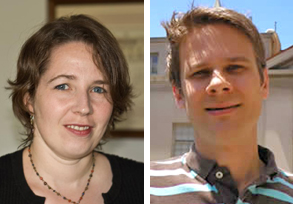A Golden Discovery for Respiratory Research
BU profs target inner workings of virus with gold nano rulers

A new technique in disease research being developed by two Boston University labs could literally be worth much more than its weight in gold.
Björn Reinhard, a College of Arts and Sciences assistant professor of chemistry, is using infinitesimal particles of gold, each about 10,000 times thinner than a human hair, to measure the inner workings of cells on a molecular level in real time. He’s collaborating with Rachel Fearns, a School of Medicine assistant professor of microbiology, who hopes to use these nanoscale measuring devices to pinpoint targets for drug therapy in the genome of respiratory syncytial virus (RSV), which infects nearly everyone in the world by age two and leads to about 160,000 deaths every year, according to the World Health Organization.
After more than a decade researching RSV, Fearns had identified some key parts of the virus’s RNA genome, and she had some idea of how these genetic sequences worked to replicate and encode virus-making instructions in the host cell. Still, she wasn’t satisfied with the pace of her progress or the level of precision available with standard experimental techniques.
“We needed to come up with new ideas and new techniques to get a sharper picture of how the virus’s RNA works inside a cell,” she says.
Enter Reinhard and his tiny golden rulers. A few months ago, he presented his research to a group of microbiologists, Fearns among them, at an interdepartmental “jam session.” His work is based on the fact that fields of oscillating electrons surrounding paired gold nanoparticles scatter light with an intensity and color spectrum that varies according to the distance between the particles. If the particles get closer, the scattered light grows redder and more intense, and if the distance between the pair lengthens, the light dims and shifts toward blue. Thus, by tethering a strand of DNA or RNA between two gold nanoparticles, researchers could introduce enzymes or pharmaceutical agents to portions of these genetic molecules and measure any length changes as a function of time. Plus, because of the small size of these probes, scores of individual molecules could be observed simultaneously on a device no bigger than an amoeba.
“Instead of taking weeks to do such measurements,” Reinhard explains, “you could do it in an afternoon and have hundreds of data points.” It was just the sort of novel experimental technique Fearns had been seeking. Until then, much of her research had involved manipulating different portions of the virus’s genome, implanting the mutant genetic sequences into about a million cultured cells, waiting a couple of days, and then observing whether, on average, the changes had prevented new virus RNA from being created.
“But we could only look for the ultimate outcome, not what might really be going on,” says Fearns. For instance, was the RNA-encoding and duplication process knocked out completely? Did it start, but then stop prematurely? Did it make unstable molecules that quickly degraded? “When you’re dealing with a molecule that has many different functions,” she says, “looking at the average of a final product is helpful, but it doesn’t give us the complete picture.”
She and Reinhard have begun using the gold nano rulers to investigate how an enzyme critical to the duplication of the virus genome manages to do its job when the RNA meant to signal it is all wrapped up in a protective protein inside the cell. Along with Robin Djang, a MED microbiology research technician, and Lynell Skewis (GRS’11), a chemistry doctoral student, they’ll start by attaching the probes to both ends of the RNA and then introduce the protective protein and observe whether the RNA-protein complex is rigid or flexible to help determine if the RNA is completely covered by the protein or if bits are exposed. Then they’ll introduce the enzyme and check to see if it is able to displace the protein from the RNA strand. Finally, they’ll label the enzyme and use the probe to measure where along the RNA the enzyme begins its work.
Fearns says this sort of intricate step-by-step look at genes and proteins at work in a cell has been something of a black box for microbiologists, who often must content themselves with knowing the final results of genetic changes, but not exactly how those changes have their effect.
“I think this is exciting, to me and others in the field, the idea that you can be looking at things on a single molecule level rather than an average of final outcomes,” she says, “because biology doesn’t function as an average.”
Chris Berdik can be reached at cberdik@bu.edu.
Comments & Discussion
Boston University moderates comments to facilitate an informed, substantive, civil conversation. Abusive, profane, self-promotional, misleading, incoherent or off-topic comments will be rejected. Moderators are staffed during regular business hours (EST) and can only accept comments written in English. Statistics or facts must include a citation or a link to the citation.